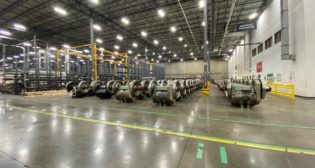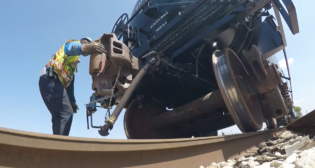
RSI-CTC to PHMSA: “One size fits all” won’t work
Written by William C. Vantuono, Editor-in-ChiefTo address these potential disruptions and safety hazards, the RSI-CTC called for “greater harmonization between the two rulemaking bodies in the U.S. and Canada,” and provided “insight and specific recommendations across a range of issues that will help reduce the risk of transporting flammable liquids by rail in North America.” The comments also urged DOT to focus more on the root causes of most derailments, “which continue to be track failure and human error, not tank car design.”
In that respect, RSI-CTC’s recommendations on tank car retrofits and phase-outs for the existing fleet differ from those submitted by the Association of American Railroads. Recommendations submitted by The Greenbrier Companies differ from both AAR and RSI-CTC, in some respects. For new-builds (designated as DOT 116), RSI-CTC and Greenbrier support PHMSA’s Option 2, which specifies 9/16-inch-thick tank shells and half-inch-thick, full-height head shields. (Some railcar builder stocks plummeted as much as 10% on Oct. 1. Wall Street analysts believe the plunge is attributable to investor wariness over an “oil tank car rule fight.”)
“RSI-CTC and independent third-party research show that the proposed U.S. rules—in their current form—would effectively force approximately 90,000 tank cars to be withdrawn from service at various times during the modification program and parked until the shop capacity required to carry out the necessary modifications becomes available,” said RSI President Tom Simpson. “Between 2018 and 2020, 30% to 50% of the total crude oil and ethanol tank car fleet would be idled at any given time. To replace the loss in 2017, the year the first compliance deadline hits, theoretically it would require 20,000 trucks carrying more than 370,000 truckloads on North American highways, a practical impossibility and potentially more hazardous outcome given the safety risk associated with transport by truck.”
In its 59 page comments to PHMSA, the RSI-CTC said it “supports a commodity-based approach for selecting the proper tank car that requires shippers to ensure materials are appropriately and safely packaged. The RSI-CTC also asked PHMSA to differentiate the requirements for new and existing cars, which will allow more new or modified cars with enhanced safety features to be put into service more quickly, rather than a one-size-fits-all approach. In addition, the RSI-CTC’s comments offer recommendations on how to optimize braking systems, thermal protection systems, and fabrication of new tank shells using normalized steel, among other technical specifications. The comments further set out a timeline that accounts for the complexity of the modifications and the practical limitations of shop capacity and available resources to complete the modifications.”
The following summarizes RSI-CTC’s modifications to PHMSA’s NPRM on HM-251:
“• The RSI-CTC supports PHMSA’s holistic approach to improving the safety of hazardous materials transportation by rail by focusing on derailment prevention in addition to post-derailment mitigation.
“• Harmonization of the U.S. and Canadian requirements is essential to ensure the viability of key segments of the North American economy.
“• A rule governing tank car specification that is predicated upon train makeup and railroad operations provides neither the necessary advance notice nor the certainty to determine packaging requirements. Accordingly, HHFT (High-Hazard Flammable Trains) is not a workable concept for determining tank car specifications, which should instead be determined by the commodity transported.
“• PHMSA’s final rule should include only feasible, cost-justified, prescriptive standards, clear definitions, and achievable timelines.
“• Newly built tank cars transporting crude oil and ethanol (in all Packing Groups) should be built with a 9/16-inch-thick tank shell, jacket, full-height half-inch-thick head shields, top fittings protection, a reconfigured bottom outlet valve handle (BOV), a reclosing pressure relief valve (PRV), TC128 Grade B normalized steel, and a thermal protection system. This is consistent with Option 2 as referred to in the NPRM.
“• Newly built tank cars transporting the balance of other Class 3, flammable liquids in Packing Group (PG) I, II, or III, should be built with a 7/16-inch-thick tank shell, jacket, full-height half-inch-thick head shields, top fittings protection, a reconfigured BOV, a reclosing PRV, TC128 Grade B normalized steel, and a thermal protection system. This is consistent with Option 3 as referred to in the NPRM.
“• Existing tank cars serving all Class 3, PG I and II commodities including crude oil and ethanol should remain in service with the existing head and shell as a base and undergo modification that would include jackets (if not already present), full-height half-inch-thick head shields, a reconfigured BOV, a reclosing and appropriately sized PRV, and a thermal protection system in accordance with 49 C.F.R. § 179.18.1 This is consistent with Option 3. The RSI-CTC agrees with PHMSA that top fittings protection is not a cost-justified modification for existing tank cars.
“• Modifications to existing tank cars transporting Class 3, PG III commodities should be limited to the application of a reconfigured BOV and a reclosing PRV.
“• The compliance deadlines for the modification program must account for the complexity of the modifications and the constraints of the maintenance and repair facility network to provide sufficient time to avoid the substantial unintended consequences of an unrealistic modification timeline.
“• We support rigorous benefit cost analysis to inform the final rule, and suggest elements of such an analysis. PHMSA’s final rule should be free of legal uncertainties that could hinder effective implementation, public safety protections, or commerce.”
The following points summarize RSI-CTC’s proposed modifications to timelines submitted to PHMSA’s Notice of Proposed Rulemaking on HM-251:
“• Legacy DOT-111 Crude Oil and Ethanol Tank Cars: All legacy (jacketed and non-jacketed) tank cars transporting crude oil (all Packing Groups) would be modified or removed from crude oil and ethanol service by Dec.31, 2020. This would require modification of approximately 36,000 non-jacketed legacy tank cars and 5,100 jacketed legacy tank cars. In the event a final rule is not in place by Jan. 1, 2015, then the compliance period would be 72 months after publication of a final rule.
“• Non-Jacketed CPC-1232s Crude Oil and Ethanol: All non-jacketed CPC-1232 tank cars transporting crude oil and ethanol (all packing groups) would be modified or removed from crude oil and ethanol service by Dec. 31, 2022. This would require modification of approximately 22,000 tank cars in crude oil service and 750 tank cars in ethanol service. In the event a final rule is not in place by Jan. 1, 2015, then the compliance period would be 96 months after publication of a final rule.
“• Legacy DOT-111s in Class 3, PG I & II Service: All legacy (jacketed and non-jacketed) tank cars transporting Class 3 Packing Group I and II materials other than crude oil and ethanol would be modified or removed from Class 3 PG I and II service by Dec. 31, 2025. This would require modification of approximately 14,300 non-jacketed tank cars and 5,400 jacketed tank cars in other flammable liquids service. In the event a final rule is not in place by Jan. 1, 2015, then the compliance period would be 120 months after publication of a final rule.
“• Jacketed CPC-1232s in any Class 3, PG I & II Service: All jacketed CPC-1232 tank cars transporting Class 3 PG I and PG II materials (including crude oil and ethanol) would be modified at next shopping event or requalification, whichever occurs first, but no later than Dec. 31, 2025. This would require modification of approximately 1,580 tank cars in other flammable liquids service. In the event a final rule is not in place by January 1, 2015, then the compliance period would be 120 months after publication of a final rule.
“• Legacy DOT-111s in Class 3, PG III Service: All legacy DOT-111 tank cars transporting Class 3 PG III materials would be modified at next shopping event or requalification, whichever occurs first, but no later than Dec. 31, 2025. This would require modification of approximately 4,925 tank cars in other flammable liquids service. In the event a final rule is not in place by Jan. 1, 2015, then the compliance period would be 120 months after publication of a final rule.”
“For years we have been advocating for a holistic approach to safety that will prevent train derailments and address tank car standards, among other issues,” said Simpson. “In our comments, we reiterated our positions and offered a comprehensive set of practical recommendations that will bring the greatest safety benefit in the quickest ways possible. For instance, we believe the timelines for modifications in the U.S. and Canada should be synchronized and feasible to avoid major disruptions of service. Moreover, the specifications for new tank cars and the rules for packaging of flammable liquids need to match up across North America. Without making these important changes to align the rules, the effect will be to deplete the fleet of tank cars available for service, and those effects to safety and the economy cannot be underestimated.
“The members of the RSI-CTC have demonstrated a strong commitment to safety. Together, the industry has voluntarily invested more than $7 billion to add tank jackets and full-height head shields, which bring the greatest improvements in tank car design and safety. We look forward to the speedy implementation of comprehensive regulations that will bring greater certainty to the market, improve the safety of rail transportation, and allow us to continue to innovate.”



